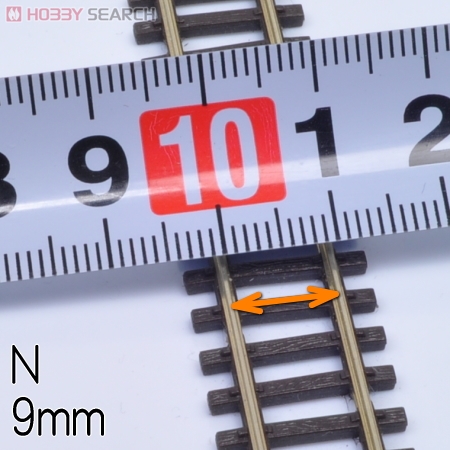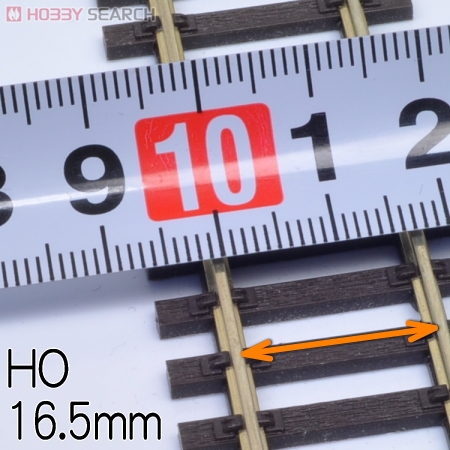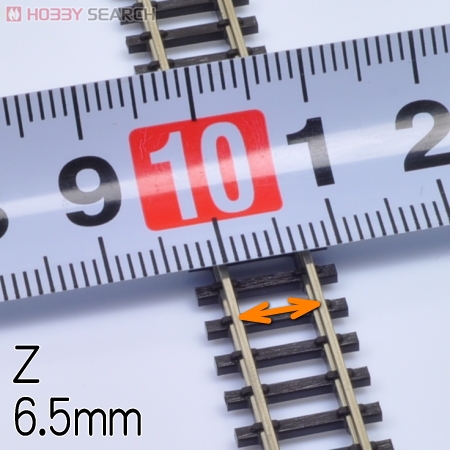Good Morning,
Kapinozuka here.
Today, the Hobby Show is being held in Shizuoka (that's the prefecture in Japan
with Mt. Fuji), and I believe there will be reports about it uploaded later, so
please bear with us.
For now, here is a little talk about Railway Models.
A railway model refers to any train models, rails, and any other accessories that
are related to these, made according to the reduced scale of the rail width (=
the width between two rails lined up in parallel, gauge). Also, models of items
such as buildings, bicycles, plants, people etc. that are seen around railways
are also included as this in a broader sense.
This basically means:

A train can't run without a track. And a track always has rails at a fixed width,
no matter how long the track is. A car can run on a road with variable width, as
long as its wide enough to drive on, but regarding railways, the width between
rails being fixed is critical.
For example, if a person enjoying railway models each decided their own width
individually, and made trains according to that particular width, other people
cannot run their trains on the same rail and play with it together, unless they
also use the same width.
 From the left, 1/80 scale
(Aclass), 1/150
scale (Kawai), 1/220 scale (Prmloco)
From the left, 1/80 scale
(Aclass), 1/150
scale (Kawai), 1/220 scale (Prmloco)
The image above, is the comparison of the freight train called Wamu 8000 type,
but although being the same model of freight train, they are all different in
scale. You can see quite clearly how different the sizes are. There are a number
of standardized scales in Railway Models, but these three are the mainstream
representatives in Japan. Let's take a look at these then, shall we?
[N
Scale]

- Details:
Track Width: 9mm
Scale: 1/148~1/160
- Main Japanese manufacturer:
Kato, Tomix, Micro Ace (ex-Arii Production company), Greenmax, Modemo etc.
- Recommended items for starters of these:
KATO Starter Set
Special Shinkansen Series N700 `Nozomi`
Amtrak P42
Superliner Starter Set (8-Car Set)
Basic Set EX Series
0 Bullet Train Set
Basic Set SD E231
Yamanote Line II
As the width is 9mm, the Japanese took the initial letter of [Nine], and calls it
the N-Gauge.
The western countries often uses 1/160 scaled trains, and is seen as the most
common scale globally.
Although in the case of Japan, the conventional lines are made at 1/150 scale,
and Shinkansen (bullet train) are at 1/160 scale. Apparently Taiwan also is at
the same scale as Japan.
Now, in the case of the UK, it's at 1/148 scale. It's very close to that of
Japan's conventional line at 1/150 scale.
Although the scales are different, the rail width and current are generally
standardized, so regardless of country, region, era etc, you can run trains of
new and old, eastern to western, a great range of trains on the same rail. This
is one of the attractions of N-scale.
Currently in Japan, its not an overstatement to say that it is the most common
gauge. This may be related to the residential issues in Japan, and the N-scale is
more likely to be able to fit a room that may not be very large, compared to the
HO-scale. As the length of each car being roughly 14cm, a nice size to fit your
palm. With the number of users and manufacturers, it has the easiest environment
as a railway model to obtain. The number of products registered here at Hobby
Search alone at the moment exceeds 8400 at March 2010, but there are a variety
that is on the market which is not recognized by us yet, so there are very many
if you consider those too.
There are 1/144 scale in the plastic model kits that are military or Gundam/robot
related, and they say it could be included in N-scale in a broad sense. After
all, they are at a relatively close scale in Japanese N-scale. However, the
western N-scale may be quite different, so they might not fit the N-scale
category depending on the gauge they are compared to.
Now, even if the rail used is 9mm width, if the scale of the train is at 1/87, it
will be [HO-scale], and similarly, 1/120 will be [TT9], thus the scale is no
longer called N-scale.
[HO Scale]

- Details:
Track Width: 16.5mm
Scale: 1/80~1/87
*
- Main Japanese manufacturer:
KTM, Endo, Tenshodo, IMON, Kato, Tomix etc.
- Recommended items for starters of these:
Kato Unitrack Rail
Set +
Kato Power
Pack Standard S +
Train of
your liking
The origin of the name is [Half of O gauge], abbreviated to HO Gauge. It
sometimes is referred to as [H0] (h-zero) too, in countries overseas.
In the western countries, it is 1/87 scale. This is the most common gauge in
western countries, it seems. The Japanese types are mostly 1/80 or 1/87 scale
used (
*)
Its smaller than O-scale, but is larger than N-scale, so the pre-completed models
(pre-assembled and colored items) are reproduced with great detail and precision,
as well as having a weighty feel to it, its worth paying close attention to.
There are also unassembled kits that has each parts such as the body, horn,
handrail, interior seating etc. reproduced with each individual parts made
separately, so you can enjoy the process of construction just like any other
plastic model construction kits. Its up to the individual how far you take it!
However, there are limitations to the amount manufactured, as well as the fact
that the product itself is a little expensive, and considering the number of
shops dealing with them, it is not as easily accessible compared to N-scale here
in Japan. The variety of products are much finer than N-scale, and with a great
range of parts as mentioned earlier, the amount of product types greatly exceeds
that of N-scale, I would believe. The number of items recorded here at Hobby
Search is over1200 as of March 2010, and there are probably so much more if you
count the items that we are not dealing with at the moment.
*Note
A Japanese train with track width of 16.5mm
gauge, and train scale being 1/80, then it should be called [No.16 Gauge], so
critically speaking, it is not quite HO scale. Therefore, many of the Japanese
trains in16.5mm gauge will be considered as [No.16], so realistically speaking,
the railway model that is common in Japan which is closest to HO-scale is the
No.16.
However, considering the width of track being 16.5mm, the scale may be slightly
different, but it can still be used on the same track anyway. Being able to run
on the same rail, you can play with a greater range of trains
So for the explanation hereafter, there are still debate in various opinions even
now, and there are number of derivations of HO scale formed too. The main debate
still lies in the idea of whither to match the gauge, or to match the
scale.
[Z Scale]

- Details:
Track Width: 6.5mm
Scale: 1/220
- Main Japanese manufacturer:
Pro Z, Prmloco, Real ZJ etc.
- Recommended items for starters of these:
Prmloco EF64 1000
Container Train Starter Set
Pro Z Yamanote Line
Entry Set (E231-500 Commuting Type) (4-Car w/Track Set)
They say the origin of the name is the last character of the alphabet, with the
thought that there will not be any scale smaller to be created.
Up 'til around 3-4 years ago, it was one of the smallest scales of railway models
in the world. Regardless of it being Western or Japanese, the scale is still
1/220 and track width 6.5mm gauge. There are some manufactures in Japan that
refers to the scale as [ZJ scale], but its basically the same as Z-scale (
*).
With the scale being one of the smallest railway models in the world, it perfect
for playing within a small space. It you form a simple circular track, it could
even fit on your desk or dining table etc. and run perfectly well on it too! And
as the pre-completed models are the mainstream for this market, you won't need to
construct it or anything, you can just take it out of the packaging and let it
run on your rail straight away!
In earlier days, the Z-scale here in Japan weren't very popular, compared to the
HO or N scales. However, with more manufactures developing and selling more of
these from around 2005, the world of Z-scale has begun widening.
Here at Hobby Search, there are only around 150 items registered as of March
2010, but it may increase later!
Now, I didn't think this 1/220 scale was used in anything other than railway
models, but apparently there were some plastic models of castles and ships etc.
at this scale as
well as some
Gundam models that
are of this scale too.
*Note
With the model being so small, the argument that
took place in HO-scale is irrelevant here, it seems. It seems that there isn't
much need to separate the general lines, shinkansen, western models, and Japanese
models etc.
[Other Scale]
Examples of other fairly known scales.
♦
T
Scale
Track width: 3mm
Scale:1/450
The origin of the name is the initial of the word Three. It is the smallest scale
of railway model in the world, as of 2009. This is a startling scale announced by
Eishindo. The motor is very small, could be that used for the vibrator of a
mobile phone, and the cars each have magnet on their wheels to increase
stability.
The items from other genre that you could enjoy playing with at the same scale
are the
plastic kits
of castles and ships etc.
♦
O Scale
Track width: 32mm
Scale: 1/43~1/48
If the HO-scale were a child, then O-scale would be the parent.
1/48 scale is often seen in
scale plastic model kits, but these can fit in the broad
sense of O-scale.
The Japanese type is 1/45 scale, but it will be called OJ Scale if the track
width is 24mm.
♦
G
Scale
Track width: 45mm
Scale: approx. 1/22~1/29 ish
A scale popular in Germany. The origin of the name is the first letter of the
German word Gross (which means big). The reason for the scale being very vague is
due to the idea that they accept anything as long as the track width is 45mm...
As a characteristic, they are large railway models, yet it can be enjoyed on
unexpectedly small space. They have endurance, and there are some products that
can be used on garden railway too. I would think
1/24 scale
plastic models would fit rather nicely amongst these.
So yeah, I've gone on about the above, but due to the space limitation of the
blog, I have described it slightly vaguely. Also, there may be some errors due to
my lack of knowledge, so please be understanding if you find anything wrong.
I might explain about the width of rails some other time, too.
 From the left, 1/80 scale
(Aclass), 1/150
scale (Kawai), 1/220 scale (Prmloco)
From the left, 1/80 scale
(Aclass), 1/150
scale (Kawai), 1/220 scale (Prmloco)
By Kapinozuka, who understand that this can be very confusing.